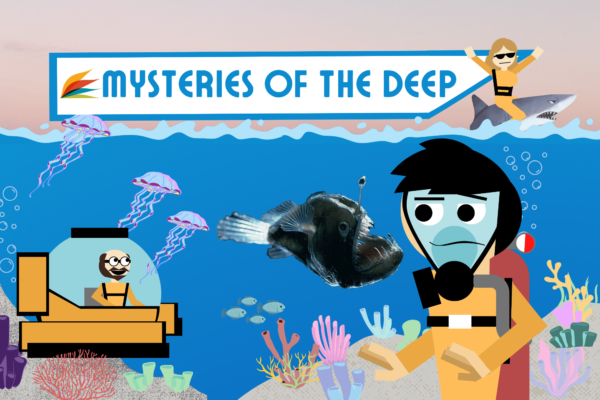
When you go to the beach, have you ever looked down at the water and wondered, “what’s down there?” The ocean is huge. As in MASSIVELY HUGE. According to the Intergovernmental Oceanographic Commission of the United Nations Educational, Scientific, and Cultural Organization (UNESCO), only 5% of the ocean has been explored and charted by humans.
Today, we will be exploring some of the deepest parts of the ocean to learn more about the coolest, weirdest, and – sometimes – scariest animals that humans have discovered!
The scariest thing about the darkness is not knowing what’s hiding in it. The knowledge you learn in this series will hopefully shine some light in that darkness and help you be a little less scared of the watery parts of our planet.
…or will it?
The Fangtooth Fish
Let’s start with the Fangtooth Fish. Commonly found about 500 and 2,000 meters (about 1.3 miles) deep in the ocean, these have been discovered going as deep as 5,000 meters. Imagine doing a 5K run, but instead of running, you swim straight down the same distance!

Here are three facts about this terrifying hunter:
- Despite the adults only being about 6 inches long, they have the largest teeth in the ocean in proportion to body size! Special pouches on the roof of their mouths prevent the fish from piercing its brain. Imagine having to adapt your body just to close your mouth!
- It has terrible vision, but it makes up for it with the lateral line, a sensitive organ that runs down the sides of its body. It uses this to feel movement and temperature changes to hunt prey! Once something is within chomping distance, it uses special chemical receptors to “smell” the animal before going in for a snack!
- Unlike other deep-sea animals that use light-producing organs or cells in their bodies, Fangtooths actually have “ultra-black” skin made of a special pigment that absorbs 99.5% of light to hide from predators in plain sight. And you thought you were good at hide and seek!
The Yeti Crab
Now for something a little less scary: the Yeti Crab. These deep ocean scavengers were discovered near Easter Island (the island in the Pacific with the giant, carved stone heads) during an expedition in March 2005. They were found as deep as 2,200 meters! What makes them so unique? Let’s find out!

Here are three facts about these fascinating, fuzzy fellows:
- They are typically found near hydrothermal vents in the deep ocean. These vents aren’t just spouts like the ones you see in a water fountain. They are areas in the ocean where EXTREMELY hot gasses from hot lava beneath the crust gush out, reaching temperatures of over 700 degrees Fahrenheit! You can cook a lot at that temperature, but somehow the Yeti Crab treats the vents like a summer beach house!
- They hold their claws over the vents to catch special bacteria that like eating the sulfur-rich minerals that come out. Based on the amount of bacteria that are found on their hair, scientists believe they are “farming” the bacteria as a possible source of food!
- They don’t have eyes! Because of this, scientists also believe that the hairs on their arms (called setae) act as chemical and physical sensors to find food and friends!
A little less scared of the ocean now that you learned about these two deep-sea animals? Great! There are plenty of things in the dark left to scare you…until you learn more about them! Visit the library and check out some books about animals in the ocean you may not have heard about. Then, check out our Gale Online Database, where you can learn more about the animals that scientists have discovered and researched. We’re sure you’ll find something to sink your teeth into (kind of like the Fangtooth during dinnertime)!





